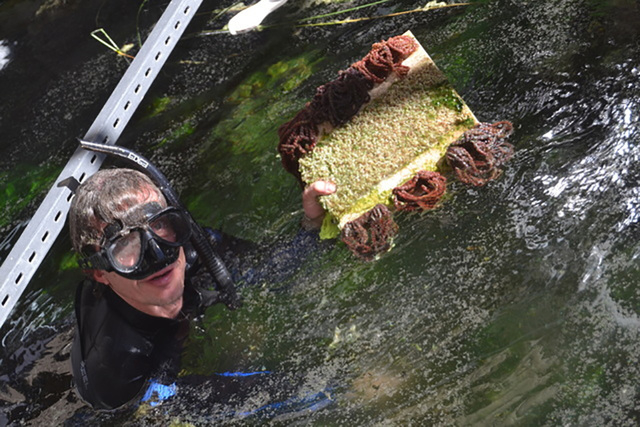As researchers fret, Devil’s Hole pupfish just keep swimming
For one of the world’s most endangered species, the Devil’s Hole pupfish is having a pretty good year.
The population of 1-inch fish appears to be rebounding, according to a count conducted earlier this month in the water-filled cavern the species calls home 30 miles northwest of Pahrump.
The annual spring count showed 115 pupfish, up from 80 last April.
Meanwhile, researchers at a multimillion-dollar lab less than a mile from Devil’s Hole continue to make strides toward establishing a captive pupfish population for future breeding and research.
Since late 2013, the team at the Ash Meadows Fish Conservation Facility has successfully raised several dozen pupfish from 1-millimeter eggs painstakingly collected from Devil’s Hole. The reserve population now totals about 50 adult fish.
That may not sound like a lot, but it’s not bad considering how little material there is to work with. The females lay only one egg at a time, and researchers are limited to collecting no more than about 10 eggs each month to minimize the impact on the wild population.
The team has yet to successfully breed pupfish in the lab. Some of the lab-raised females have produced eggs, but none of those eggs developed.
“We’re still trying to crack that nut,” said facility manager Corey Lee from the U.S. Fish and Wildlife Service.
Before 2013, pupfish had never been successfully hatched and raised in captivity using eggs collected from Devil’s Hole.
In early 2014, the lab team released its first batch of 29 captive-raised pupfish into a state-of-the-art refuge tank at the facility. The 100,0000-gallon tank is designed to replicate the fish habitat in Devil’s Hole, right down to its shape and temperature. The 90-plus-degree water in the tank comes from the same thermally-heated source that fills Devil’s Hole.
In February, Lee and company moved a second, smaller batch of fish into the refuge tank.
“Pretty much the moment we moved them out there we started seeing tons of spawning activity,” he said.
The Devil’s Hole pupfish have been under federal protection since 1967, but extinction remains a very real possibility.
The population peaked at 544 in 1990 but began to decline in 1996 for reasons experts still can’t explain.
The spring survey in 2013 turned up just 35 pupfish, the lowest total since regular counting began more than 40 years ago.
Now the numbers seem to be trending up again, as does the relative health of the population.
“The fish this year looked very healthy and active,” said Kevin Wilson, an aquatic ecologist for Death Valley National Park.
Wilson was one of seven people who donned scuba gear to count pupfish during a series of dives on April 9 and 10.
At the surface, the pool is about 8 feet wide and 60 feet long, with a shallow shelf where the pupfish spend most of their time. But the cavern angles down into the groundwater table to an undetermined depth well over 435 feet. Some have called it “the deepest cave in North America,” Wilson said.
The pupfish rarely go down more than about 100 feet, so that’s where the population counts start.
Divers work in teams, logging fish at varying depths while researchers at the surface count the ones in the shallows, Wilson said. The entire process takes 45 minutes to an hour and is repeated several times to account for the vagaries involved in tracking tiny, moving fish.
“There is the possibility of counting the same fish more than once or missing a fish altogether,” Wilson said.
The dive team also captures high-definition video footage that can accurately measure the fish using special software originally developed to chart the growth of far larger test subjects, namely whale sharks and farm-raised tuna.
“We do that because we can’t handle the pupfish,” Wilson said.
Work in the lab can be even more time-consuming and tedious. Over the last six months of 2014, for example, researchers collected only a handful of viable eggs from Devil’s Hole and produced just six fish.
“They were very well cared for,” Lee said with a laugh.
The aquariums at the lab currently hold 17 pupfish, all hatched within the last two months.
Ultimately, they will need a couple hundred fish to establish a “self-sustaining population” in the refuge tank, Lee said.
The research team planned to head back to Devil’s Hole on Monday this week to gather more eggs.
Contact Henry Brean at hbrean@reviewjournal.com. Find him on Twitter: @RefriedBrean
















